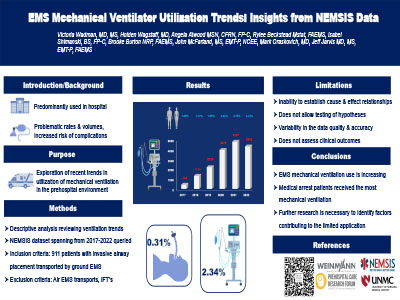ABSTRACTS
Increasing Utilization of Mechanical Ventilation in Prehospital Settings: Insights from NEMSIS DataAuthor: Victoria Wadman, Holden Wagstaff, Isabel Shimanski, Brooke Burton, Charlotte Rogers, Rylee Beckstead, John McFarland, Angela Atwood, Mark Oraskovich, and Jeff Jarvis | | Associate Authors:
Introduction: Mechanical ventilation is a critical intervention recommended for patients with invasive airways in the prehospital setting. The National Association of EMS Physicians (NAEMSP) advises consideration of mechanical ventilation following advanced airway placement over manual ventilation. However, there is limited information regarding the prevalence and trends of mechanical ventilation in this context. Objective: To investigate trends in mechanical ventilation among patients with successful invasive airways following 9-1-1 activations. Methods: A retrospective analysis of data from the National Emergency Medical Services Information System (NEMSIS) public-release dataset, spanning from 2017 to 2022, was performed. The study population included patients who had successfully received invasive airways, excluding those involved in interfacility transfers and air-medical services. The primary outcome measured was the rate of mechanical ventilation among these patients. Secondary outcomes included the total duration of mechanical ventilation and the proportion of time mechanical ventilation was used during the total airway time. Descriptive statistics were utilized to summarize the characteristics of patients and emergency medical services (EMS) agencies that implemented mechanical ventilation. Results: Out of 210,295,055 encounters analyzed, 656,759 patients (0.31%) received invasive airways. Among these, 15,339 patients (2.34%) were mechanically ventilated with a median age of 64 [50,75]; 53.87% were non-Hispanic White, and 40.89% were female. The median invasive airway time was 18.98 minutes (IQR = 11.55–28.03); the median mechanical ventilation time was 18.58 minutes (IQR = 12.00–29.47). The proportion of time patients were mechanically ventilated was 0.81. The invasive airway that was most frequently utilized for mechanical ventilation was endotracheal tubes (77.58%). Mechanical ventilation was most frequent in urban areas (73.30%). The most common indication for mechanical ventilation was medical arrest (49.73%). Notably, the utilization of mechanical ventilation among patients with invasive airways increased from 1.39% in 2017 to 2.41% in 2022. Conclusion: The use of mechanical ventilation in patients with invasive airways in the prehospital setting is on the rise. Further research is necessary to elucidate the factors contributing to the limited application of this critical intervention.
|

